Cao Z. (Ed.) Thin Film Growth: Physics, materials science and applications
Подождите немного. Документ загружается.


© Woodhead Publishing Limited, 2011
228
10
Epitaxial growth of graphene thin films on
single crystal metal surfaces
J. Coraux, Institut Néel, France and a. T. N’DIaye,
C. busse and T. MIChely, universität zu Köln,
Germany
Abstract: epitaxial growth of graphene on metals has been known about
for ve decades and has encountered renewed interest since 2006–2007
when it was realized that graphene mass production is a major hurdle in
the development of graphene-based applications. With the help of model
systems, i.e. prepared in clean conditions (ultra-high vacuum) and at
clean surfaces (single-crystalline metallic ones), much progress has been
made towards the understanding of graphene growth on metals, from
the elementary processes governing growth towards the tailoring of the
morphology of the graphene samples.
Key words: graphene, metals, chemical vapour deposition, defects, structure,
edges, multilayer, growth processes.
10.1 Introduction
Graphene is the name given to an atomically thin layer of sp
2
-hybridized
carbon (Fig. 10.1). Its unconventional properties were explored by researchers
from 2004, after it was isolated by A. Geim and colleagues. in Manchester
by mechanical exfoliation of graphite (Novoselov, 2004). Such samples
have fuelled exceptionally sustained research owing to their high structural
quality, and they are set to keep revealing a wealth of remarkable properties
resulting from the high surface to volume ratio, mechanical properties,
chemical inertness, electronic band structure, etc., of graphene (Geim, 2009).
a consensus has emerged as to the necessity for alternative preparation
methods, because of large deviations in the quality of samples obtained by
mechanical exfoliation, and because this technique is very fastidious, together
precluding the reliable and efcient production of graphene. Accordingly
alternative preparation methods have been explored, among which are
epitaxial growth on silicon carbide and on metals. In contrast to silicon
carbide, single-crystalline metal substrates can yield high-quality graphene
with one layer uniformly covering a surface (some applications then require
the transfer of graphene onto an adequate support). another direction in
graphene research focuses towards understanding properties, possibly new
ThinFilm-Zexian-10.indd 228 7/1/11 9:42:47 AM
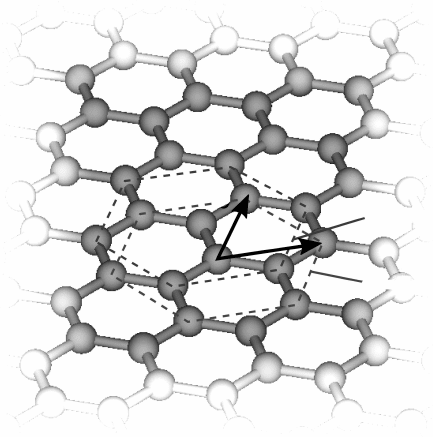
229Epitaxial growth of graphene thin films on single crystal metal surfaces
© Woodhead Publishing Limited, 2011
ones, resulting from its interaction with an environment, in particular with a
metal, which has obvious relevance when considering the graphene/electrode
contact. Graphene prepared directly on metal surfaces, which has been known
for decades (Banerjee, 1961; Karu, 1966; Irving, 1967; Presland, 1969),
provides a system ideally suited to address such issues.
Growth processes are often monitored by ne inspection of a system’s
structure. Therefore we rst describe the structure of graphene on metals
including the defects that are commonly encountered. We then focus on the
growth of graphene. Throughout the discussion, we lay emphasis on the
strong inuence of the metal–graphene interaction upon growth processes and
consequently graphene’s structure. based on our studies of graphene growth
on iridium and other contributions in the literature, we review conditions
for obtaining high-quality graphene.
10.2 Structure of graphene on metals
The C–C bond is one of the strongest in nature (3.61 eV for a single bond),
stronger than the bond between carbon and a noble metal. This explains
why sp2 carbon (more stable than sp3) and the noble metal coexist as two
separate phases, at least at room temperature and ambient (or below) pressure.
As we shall discuss in Section 10.3, graphene or multilayer graphene can
b
Æ
a
Æ
Sublattice B
Sublattice A
10.1 Schematics of graphene’s honeycomb structure showing the
two carbon hexagonal sublattices in different shades. The unit cell is
defined by the two lattice vectors represented with black arrows.
ThinFilm-Zexian-10.indd 229 7/1/11 9:42:48 AM
230 Thin film growth
© Woodhead Publishing Limited, 2011
be obtained. The epitaxial relationship is more or less well dened: while
the texture orientation is unique ([0001] direction of graphene or graphite
parallel to the dense-packed metal surface normal), the azimuthal (in-plane)
orientation can be multiple, either because different variants can be formed, or
because the azimuthal orientation scatters around an energetically favourable
situation. Graphene is the stiffest material known to date (Lee, 2008), which
has important consequences for its structure: biaxial strains in graphene
resulting from its epitaxial growth are restricted to a few tenths of a percent,
which renders graphene’s lattice incommensurate with that of the substrate in
the general case. Due to the exibility of graphene, delaminations (wrinkles)
are possible in response to thermal mismatch between the substrate and
graphene. Graphene can also bend up or down at substrate edges.
10.2.1 Commensurate or not
among transition metals, Co and Ni dense-packed surfaces exhibit only
small lattice mismatches with graphene, of 1.8 and 1.2% respectively (for
Fe, this is only 0.9%, but presumably due to the large solubility of C in Fe
at ambient conditions, the control of the number of graphene layers on Fe
is almost impossible). Considering graphene’s high young’s modulus (lee,
2008), stretching the graphene to match the metal lattice parameter would,
however, imply that the metal can sustain a considerable amount of stress,
actually more than its breaking strength. This is in apparent contradiction
with experimental observations pointing to a commensurate graphene
layer on the metal. This contradiction may be explained if one considers a
possible change of graphene’s mechanical properties upon its bonding on the
metal (which is strong on Co or Ni). electron diffraction revealed a (1 ¥ 1)
(commensurate) superstructure for graphene/Ni(111). In this superstructure
half the carbon atoms sit on top of the Ni atoms in the topmost substrate
layer, and the remaining carbon atoms sit on top of the Ni atoms in the third
(relative to the topmost Ni layer) substrate layer. The former carbon atoms
are slightly higher than the latter (Gamo, 1997) (Fig. 10.2a).
The situation is more complex in the case of a larger lattice mismatch
between graphene and the substrate. This is the case for a number of transition
metals, like Cu(111) (4% lattice mismatch with graphene), Ir(111), Pt(111),
or Ru(0001) (~10%). With such substrates the coincidence of the graphene
and metal surface lattices can only be local and partial: if at a given location
the centres of carbon rings approximately prolong the fcc(111) or hcp(0001)
atomic arrangement of the metal atoms below, a few nearest neighbour
distances away, this coincidence is lost. This gives rise to a periodic lattice
with the symmetry of the less symmetric surface in the {graphene,metal}
system. In the case of graphene on a metallic surface with hexagonal
symmetry, the superlattice exhibits hexagonal symmetry too. such lattices
ThinFilm-Zexian-10.indd 230 7/1/11 9:42:48 AM
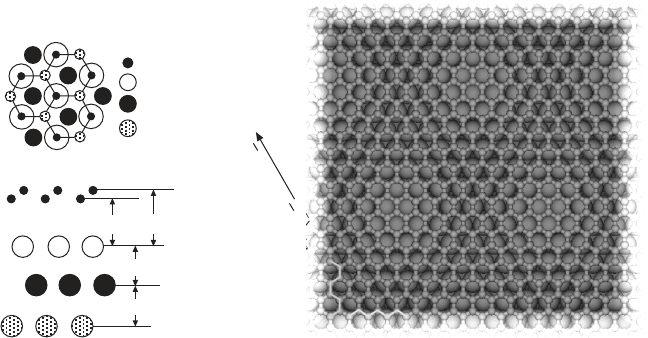
231Epitaxial growth of graphene thin films on single crystal metal surfaces
© Woodhead Publishing Limited, 2011
are encountered in various systems, such as metal/metal epitaxial systems
or oxide layers on metals (see, for instance Wiederholt (1995) and ritter
(1998), respectively). Coincidence site lattices are often described following
a moiré pattern (Fig. 10.2b), by analogy with the optical beating fringes
appearing when looking through two thin, transparent, superimposed tissue
veils (historically composed of bres from angora goats, a type of textile
whose name was adapted from arabic to French as ‘moiré’ and to english
as ‘mohair’) with similar bre structure. For convenience and consistency
with the literature, we hereafter use the term ‘moiré’.
Interesting geometric properties are associated with moirés (amidror,
2007). It can be shown that in the case when the metal surface dense-packed
directions align with <11–20> directions in graphene (zigzag directions),
the lattice parameter of the moiré (a
moiré
) can be written in a simple way as
a function of the lattice parameter of the metal (a
m
) and of graphene (a
C
):
1/a
moiré
= 1/a
C
– 1/a
m
. This implies that a
moiré
is inversely proportional to
the lattice mismatch between graphene and the metal. For ~ 10% lattice
mismatches between graphene and the metal, a
moiré
is in the range of 2–3 nm,
for graphene on Cu(111), a
moiré
was recently found to be 6.6 nm (Gao, 2010;
Zhao, 2011). Note that the geometrical parameters of the moiré (orientation,
lattice parameter) are very sensitive to faint variations of those of the metal
and of the graphene, which allows a ne description of the graphene or metal
structure (Coraux, 2008; N’Diaye, 2008b, 2009a).
·112
0Ò
C
|| ·101
Ò
Ir
Top view
Side view
C
1st Ni
2nd Ni
3rd Ni
2.11Å 2.16Å
1.96Å
2.09Å
±0.07Å
(a) (b)
10.2 (a) Structural model for graphene on Ni(111) derived from a fit
of I-V LEED spectra (from Gamo, 1997, © Elsevier); (b) ball model for
a moiré between graphene and a Ir(111) plane. Section of zigzag and
armchair carbon rows are highlighted in the bottom left corner.
ThinFilm-Zexian-10.indd 231 7/1/11 9:42:49 AM
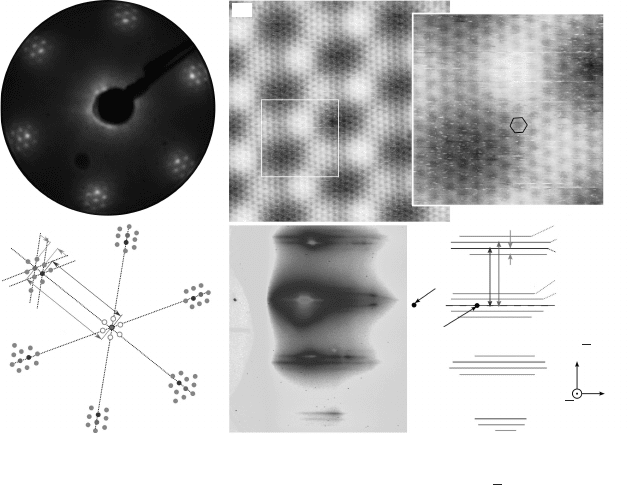
232 Thin film growth
© Woodhead Publishing Limited, 2011
standard techniques that have been used for identifying graphene’s structure
are surface science ones, most prominently low-energy electron diffraction
(leeD), also scanning tunnelling microscopy (sTM), and to a much lesser
extent reection high-energy electron diffraction (RHEED) or surface X-ray
diffraction (SXRD). As an illustration, Fig. 10.3 shows characteristic signatures
for graphene on lattice mismatched transition metals using leeD, sTM and
rheeD. The leeD pattern displays a sixfold symmetry, appearing as six
groups of spots. The ner structure of these groups reveals two prominent
spots (the outer one for the metal, the inner one for graphene) and satellites
spots that arise from the moiré (N’Diaye, 2008b). STM captures the atomic
structure of graphene (dark spots are centres of carbon rings) modulated by
a larger scale superstructure with a periodicity in the range of 2–3 nm, which
is the moiré pattern (Land, 1992). The RHEED diagrams show sets of crystal
truncation rods whose streaky character point to the atness (except for the
moiré corrugation) of the surface. such patterns are observed periodically
every 60°, in agreement with the sixfold symmetry of the surface. Besides
the zero-order central rod, strong rst-order rods are related to the graphene
(inner) and metal (outer) lattices (see solid arrows in Fig. 10.3c). These
main rods are surrounded by satellite ones, which are related, similar to the
satellite spots in LEED, to the moiré (dotted arrows in the gure).
#1/a
moiré
#1/a
moiré
#1/a
lr
#1/a
C
#1/a
lr
#1/a
C
(a)
(b)
(c)
Direct beam
Specular beam
1st moiré
1st graphene
1st lr
2st moiré
1st moiré
0th
(2
11)
(111)
10.3 (a) LEED pattern measured with 80 eV electrons, (b) STM
topographs (left: 8.8 ¥ 8.8 nm
2
, right: 2.5 ¥ 2.5 nm
2
), and (c) RHEED
pattern recorded with 10 keV electrons, along the [2
11] azimuth,
for graphene on Ir(111).
(011)
ThinFilm-Zexian-10.indd 232 7/1/11 9:42:50 AM
233Epitaxial growth of graphene thin films on single crystal metal surfaces
© Woodhead Publishing Limited, 2011
Finally, note that the above discussion applied to graphene on metal surfaces
with a threefold symmetry. Much less literature addresses graphene prepared
on, for example, (100) surfaces of fcc metals (Hamilton, 1980; Zhao, 2011)
or (110) surfaces of body-centred cubic metals. On these metals graphene/
metal moirés are also found, but their symmetry is decreased compared to
that of moirés with graphene on threefold symmetric surfaces.
10.2.2 Height of the graphene sheet
The distance between the metallic surface and the graphene surface is
characteristic of the metal/graphene interaction. extreme cases for this
interaction are van der Waals binding, such as in between the graphite plane,
and strong hybridization of the metal d bands with the p bands of graphene.
While the rst case mostly preserves the conical character of graphene p
bands, the second deeply modies them, causing band gap opening at the K
point in the brillouin zone and bending of the bands. In both cases, charge
transfer between graphene and the metal is a priori expected.
In the case of dominating van der Waals interactions, as in graphite, the
graphene–metal distance is expected to be close to the graphite interplane
distance, i.e. around 0.345 nm. In the opposite situation, the carbon and
metal atoms form bonds with a covalent character, therefore the distance
is expected to be much shorter (e.g. 0.21 nm for graphene/Ni(111); Gamo,
1997).
The graphene–metal distance remains poorly characterized at experimental
level. This is mainly ascribed to the limitations of the techniques that are
commonly employed: sTM has so far been unable to disentangle topographic
and electronic contributions to the apparent height measurements in the
graphene–metal system (Marchini, 2007; Vazquez de Parga, 2008); atomic
force microscopy (aFM) was only used in air for graphene on metals, so
that the sensitivity of the technique does not allow for a sufciently accurate
determination of the height. The only techniques which proved relevant up to
now are LEED I-V measurements and SXRD which were applied to graphene
on Ni(111), Ru(0001), and Pt(111) (Gamo, 1997a; Martoccia, 2008; Sutter,
2009a; Moritz, 2010). The analysis of the SXRD data relies on the choice
of structural models a priori, which introduces an (unknown) uncertainty
in the value of the graphene–metal height. The LEED I-V analysis is based
on the simulation of electron reectivity using a dynamical diffraction
framework, which allows a partial agreement between the simulations and
the experiment, thus imposing careful interpretation of the simulations.
Concerning theory studies, a number of reports provide estimates of the
graphene–metal distance (Bertoni, 2004; Nemec, 2006, 2008; Giovannetti,
2008; Wang, 2009; Khomyakov, 2009; Ran, 2009). Yet, noticeable deviations
are found, for example for graphene/Pd(111) (Nemec, 2006; Giovannetti,
ThinFilm-Zexian-10.indd 233 7/1/11 9:42:50 AM
234 Thin film growth
© Woodhead Publishing Limited, 2011
2008). It can be argued that the geometry used for the calculations is frequently
over-simplied. The approximations employed to perform the ab initio
calculations yield different results: the local density spin approximation is
known to result in overbinding, while the generalized gradient approximation
is expected to result in large graphene–metal distances as suggested by
the over-estimation of the graphene–graphene distance in graphite. Most
important, for a long time van der Waals interactions were not included in
the calculations and are only now starting to be considered (Vanin, 2009;
Lazic, 2010; Busse, 2011).
The difculty in assessing the graphene–metal height also concerns the
modulation of this height in the case of graphene–metal systems with a moiré.
So far, with the exception of one experimental report (Martoccia, 2008),
only demanding rst principle calculations were employed in this respect
(N’Diaye, 2006, 2008a, Feibelman, 2008; Wang, 2008; Brugger, 2009).
From these works it seems that graphene height is modulated between 0.30
and 0.38 nm on Ir(111), a system for which graphene–metal hybridization
is a priori weak (Pletikosic, 2009). On Ru(0001), the height was claimed
to vary between 0.22 and 0.37 nm (Wang, 2008): for the regions where the
height is lower, there is a strong covalent-like graphene–Ru interaction.
10.2.3 Orientation variants, small-angle twins and
dislocations
The epitaxial relationship between graphene and the metal is well dened
along the direction perpendicular to the graphene and metal surface planes:
[0001] for graphite parallel to [111] (fcc metal) or [0001] (hcp metal)
direction. This is not always the case in the plane of the graphene and metal
surfaces, in other words, there exist several preferred azimuthal orientations
for graphene on metal (orientation variants) and the orientation of graphene
may uctuate around these preferred situations. It was recently argued that
the weaker the graphene–metal interaction, the less well dened should the
graphene azimuthal orientation be (Sutter, 2009a).
The formation of several orientation variants was highlighted for graphene/
Ir(111) for specic preparation conditions (Loginova, 2009a, 2009b), for
which four orientation variants were identied (Fig. 10.4a). The azimuthal
twin between each variant is large, for several to several tens of degrees.
obviously, each variant represents a local minimum for the total energy
of the graphene–metal system. It seems, however, that the conguration
corresponding to the dense-packed metal rows aligned to the carbon zigzag
edges is more energetically favourable as it always forms rst and can be
exclusively obtained for graphene/Ir(111) in some growth conditions. also
consistent with this larger stability is the fact that this rotation variant is
more inert against oxidation (van Gastel, 2009). Rotational variants were
ThinFilm-Zexian-10.indd 234 7/1/11 9:42:50 AM
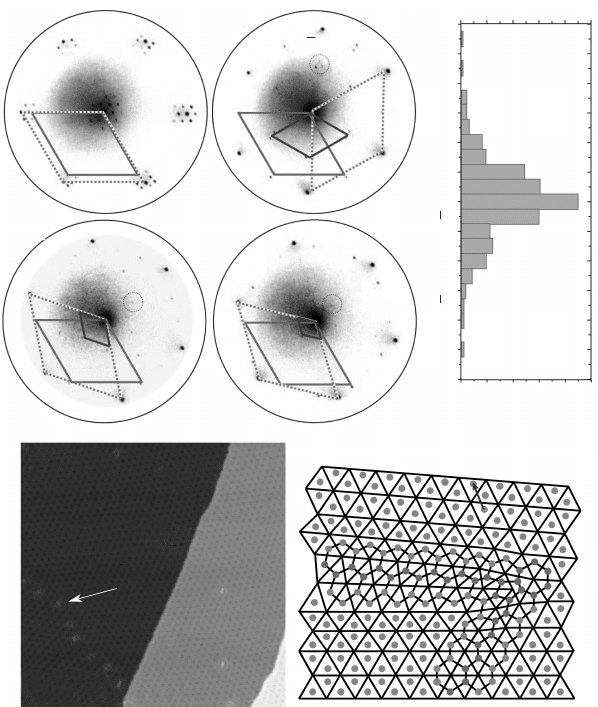
235Epitaxial growth of graphene thin films on single crystal metal surfaces
© Woodhead Publishing Limited, 2011
(a)
(b)
0° 30°
√ 3
moiré
18.5°
14°
(c)
Domain B
Domain A
A
B
b
Æ
0 20 40 60 80 100
Count
–1.2 –1.0 –0.8 –0.6 –0.4 –0.2 0 0.2 0.4 0.6 0.8 1.0 1.2
Angle between ·112
0Ò
C
and ·101Ò
Ir
(°)
10.4 (a) Micro-LEED pattern for each of the four rotational variants
for graphene on Ir(111), corresponding to a rotation of 0°, 30°, 18.5°
and 14° of the carbon zigzag rows with respect to the dense-packed
rows of Ir(111). The dark grey, dotted, and light grey rhombus
highlight the Ir(111), graphene, and moiré unit cells, respectively
(from Loginova, 2009a, © The American Physical Society, http://
prb.aps.org/abstract/PRB/v80/i8/e085430). (b) Distribution of angles
between the graphene zigzag rows (<11-20>) and the dense-packed
rows (<10-1>) of an Ir(111) surface for the energetically preferred
0° rotational variant. (c) (left) STM topograph (108 nm ¥ 108 nm
2
)
showing three domains with a different orientation of graphene on
Ir(111) and (right) the atomic structure of defects, such as the one
indicated with an arrow on the left panel, which the grain boundaries
consist of (adapted from Coraux, 2008, © The American Chemical
Society). Note that the observed superstructure is the graphene/
Ir(111) moiré and that it amplifies small-angle twins. A and B mark
two of the domains; the arrow highlights one of the typical defects
forming the grain boundary.
ThinFilm-Zexian-10.indd 235 7/1/11 9:42:51 AM
236 Thin film growth
© Woodhead Publishing Limited, 2011
also found for graphene/Pt(111) (Sasaki, 2000; Sutter, 2009a), but it has
not been possible so far to achieve a single orientation, suggesting that all
variants have comparable stability.
Depending on the growth conditions (see Section 10.3), the azimuthal
orientation of graphene might be more or less well-dened around each
orientation variant (N’Diaye, 2008b). The scatter in this orientations is
characterized by a few tenths of a degree only for graphene/Ir(111) if
graphene is prepared above 1000°C (Fig. 10.4b), and several tens of degrees
if graphene is prepared at 600°C (Coraux, 2008). The smallest scatters can
be efciently characterized by analysing the moiré scatters, which largely
amplify the carbon lattice ones (Coraux, 2008; N’Diaye, 2008a).
at the boundary between graphene domains that are twinned (scattered
twins or orientation variants), the carbon lattice tends to minimize the number
of dangling bonds through the formation of edge dislocations, that is pairs
of a heptagon and a pentagon (Coraux, 2008) as shown in Fig. 10.4(c). Such
defects are known to accommodate twin boundaries (Bollmann, 1964).
10.2.4 Other defects
Deviations from the pure two-dimensional honeycomb structure of graphene
might be considered as defects. a detailed review of defects would include
a discussion of their origin, stability and electronic properties, and is beyond
the scope of this chapter. Defects can be intrinsic to the graphene itself,
which is the case for vacancies, substitutional atoms, or graphene edges (Fig.
10.5a). They can also be extrinsic, such as being imposed by the graphene
environment, which is the case for graphene undulations induced by those
of the substrate (e.g., step edges) or thermally induced delaminations (Fig.
10.5b). Intrinsic defects for epitaxial graphene are so far poorly characterized.
extrinsic ones are better explored. Graphene wrinkles (linear delaminations)
present after cooling samples down to room temperature following growth
are due to the mismatch of thermal expansion coefcients. The wrinkle
formation actually sets in at a well-dened temperature (whose value depends
on the growth temperature) when cooling samples down (N’Diaye, 2009a),
corresponding to a situation when strain accumulation becomes unfavourable
as compared to a loss of graphene/substrate binding energy and accompanying
bending energy associated with graphene delamination. such defects were
rst investigated for epitaxial graphene on SiC (Cambaz, 2008; Biedermann,
2009; Sun, 2009), and further for graphene on metals (Kim, 2009; Obraztsov,
2007; Chae, 2009; Loginova, 2009a; N’Diaye, 2009a; Sutter, 2009a). Their
nucleation occurs abruptly within a fraction of a second, presumably at
the location of defects in graphene or around substrate step edges where
the graphene lattice is already bent (Chae, 2009). Their propagation is to
the contrary progressive (Sutter, 2009a). The formation of wrinkles (when
ThinFilm-Zexian-10.indd 236 7/1/11 9:42:51 AM
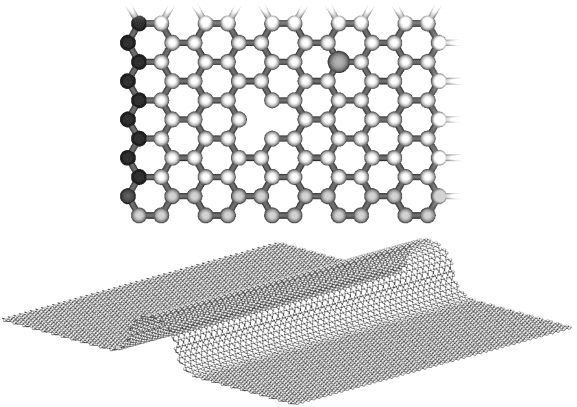
237Epitaxial growth of graphene thin films on single crystal metal surfaces
© Woodhead Publishing Limited, 2011
cooling down the sample from growth temperature) and their suppression
(upon heating up the sample again) were shown to take place at distinct
temperatures, pointing to a hysteresis.
The bending of the graphene lattice by the substrate step edges (the
graphene lattice is not interrupted by the step edges) was mainly addressed
for graphene in epitaxy on metals, for both Ru(0001) (Pan, 2007) and Ir(111)
(Coraux, 2008) substrates. The graphene lattice was shown to be continuous
across the substrate step edges. on Ir(111) the radius of curvature could even
be evaluated by taking benet of the graphene/Ir(111) moiré and its high
sensitivity to sub-Ångström displacements. It was found to be close to that
of thinnest single wall carbon nanotubes, i.e. approximately 0.27 nm.
10.3 Growth of graphene on a metal
In discussing graphene growth on metals, one may consider several situations,
rst depending on the nature of the carbon source and the way it is provided,
then depending on the afnity of carbon with the metal substrate. Both
aspects can be linked. For instance, carbon solubility in Ni is of the order
of 1 at% at 1000°C, a temperature which is often used for graphene growth
on Ni, and drastically drops at lower temperature, so that graphene growth
can proceed from segregation of carbon dissolved in bulk Ni, which may be
(a)
(b)
10.5 (a) Vacancies (missing atom in the carbon lattice), substitutional
atoms (replacing a carbon one, shown with a larger radius), and
graphene edges (black: zigzag, grey: armchair); (b) wrinkle formed in
graphene following delamination from the substrate (not shown).
ThinFilm-Zexian-10.indd 237 7/1/11 9:42:52 AM
